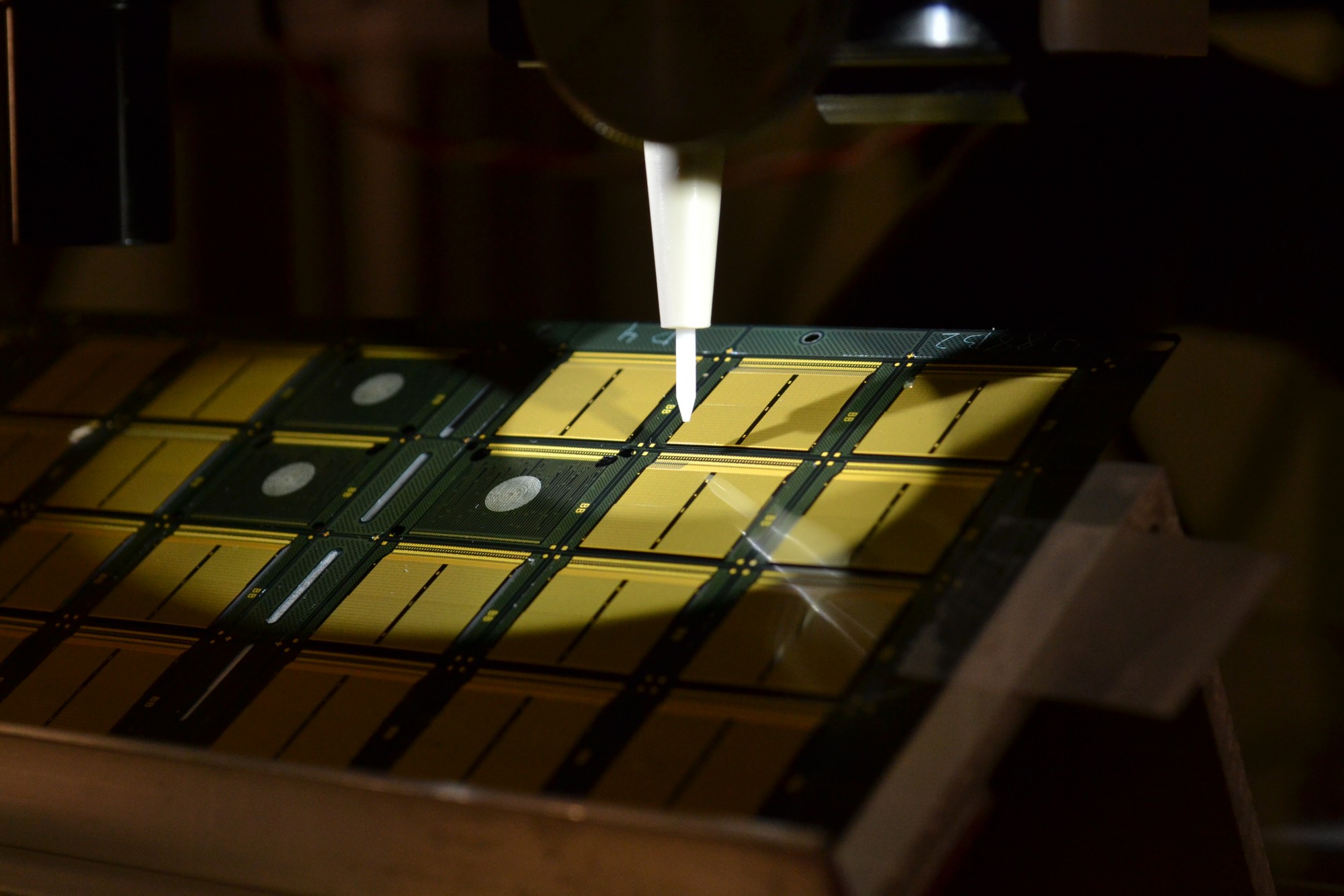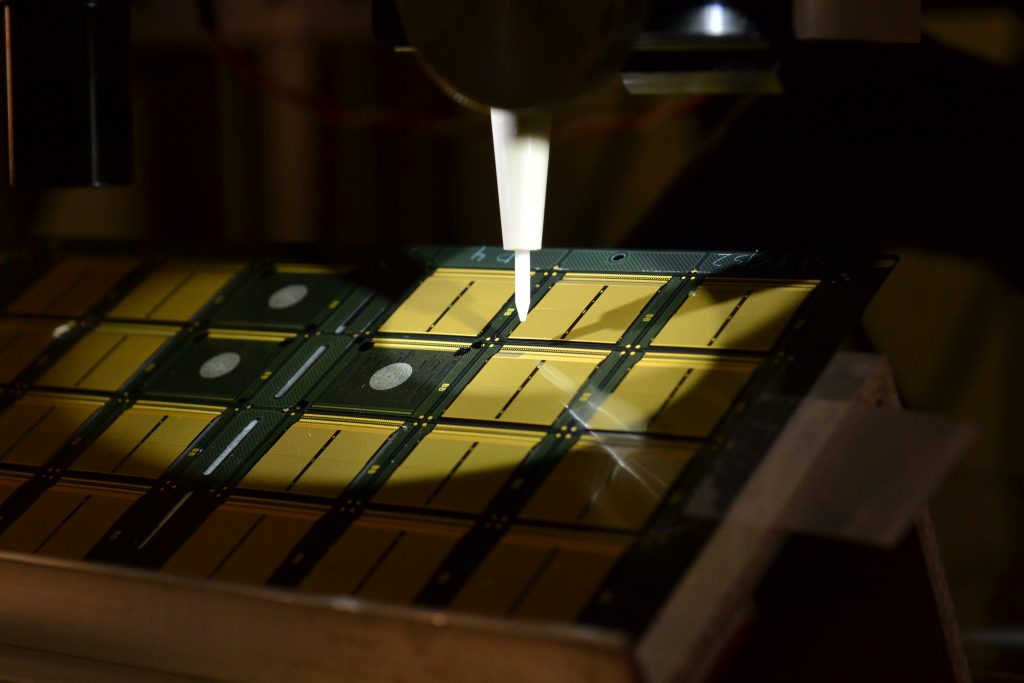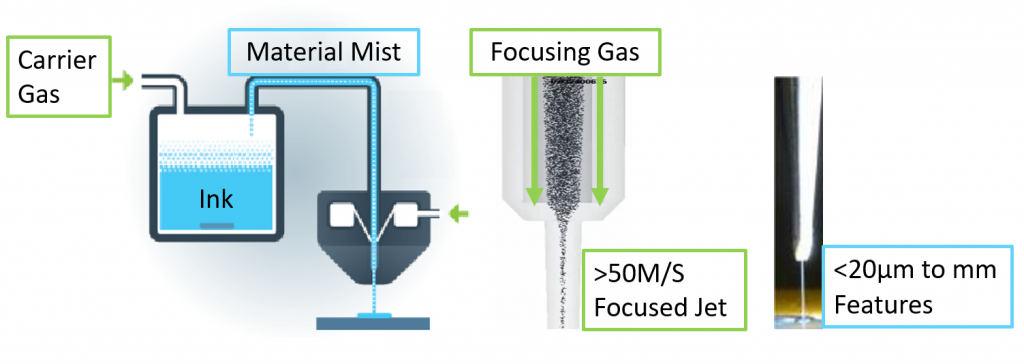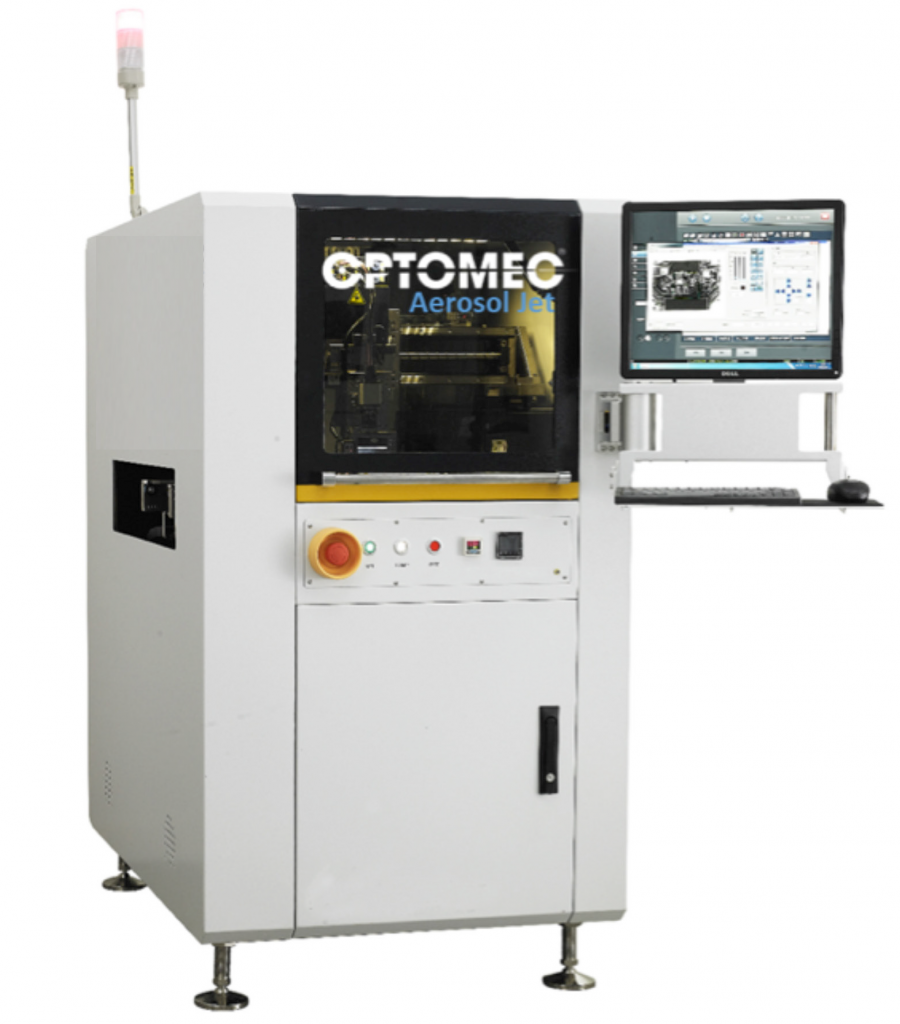Optomec Systems Improve High Volume Electronics Packaging Lines

The Aerosol Jet HD series of in-line digital dispense systems can direct print conformal 3D interconnects as an alternative to wire-bonding. Key benefits are smaller footprint, lower package height, reduced cross-talk and improved mechanical reliability. (Image courtesy Optomec)
March 7, 2018
A manufacturing solution that delivers a five-times improvement factor should catch anyone’s attention. In the world of high density electronics, this is a particularly significant improvement because until now, automated direct-dispense systems have been limited in the feature size they can produce.
 The Aerosol Jet HD series of in-line digital dispense systems can direct print conformal 3D interconnects as an alternative to wire-bonding. Key benefits are smaller footprint, lower package height, reduced cross-talk and improved mechanical reliability. Image courtesy Optomec.
The Aerosol Jet HD series of in-line digital dispense systems can direct print conformal 3D interconnects as an alternative to wire-bonding. Key benefits are smaller footprint, lower package height, reduced cross-talk and improved mechanical reliability. Image courtesy Optomec.Optomec of Albuquerque NM has just announced a compact, modular version of the company’s Aerosol Jet material-dispensing equipment, called the Aerosol Jet HD (high density) system. This unit is targeted to high-volume 2D and 2.5D (stacked die) packaging applications, creating 3D interconnects, conformal RF/EMI shielding, and precision deposition of insulators and adhesives. The industry is demanding increasingly dense printed features, as small as 20 microns, yet currently has difficulty automating even a 100-micron process.
Smaller, Lighter, Cheaper Electronics Production
Traditionally, electronic chips (dies) are connected by a multi-step wire-bonding process. By dispensing (printing) the fine connections instead, Aerosol Jet printing simplifies and speeds up the entire electronics packaging process. Optomec’s Aerosol Jet fine-feature material deposition process uses an aerodynamic focusing technique to collimate a dense mist of micro droplets into a tightly controlled beam of material that can print features. Image courtesy Optomec.
Optomec’s Aerosol Jet fine-feature material deposition process uses an aerodynamic focusing technique to collimate a dense mist of micro droplets into a tightly controlled beam of material that can print features. Image courtesy Optomec.For years, Optomec has been running Aerosol Jet systems 24/7 at various customer sites, printing smart-phone antennas directly on phone cases, adding visual strain gauges on turbine blades and creating specialty metal coatings. The company has honed its equipment to be increasingly robust, able to handle high volumes, and scalable in both hardware and software capabilities. This latest unit is both compact and modular and is designed as a slide-in replacement for dispensing equipment used in today’s electronics packaging production lines.
Mike O’Reilly, Optomec product manager, explains that the company is expanding into mainstream market opportunities where the end-products are primarily consumer-oriented devices. Production systems in this area generate millions of devices a day, so the equipment must be highly reliable, run unattended for multiple hours without needing refills of dispensing materials, and offer options that adjust the system to changing requirements.
“The smallest standard feature size today is 100 microns,” says O’Reilly, “so we sell a production process that guarantees that they can print this. Then if they want to, they can scale to a 50-micron process, because the next generation set of materials is going to require this. And beyond that, we already have a process that guarantees (dispensing) 20-micron features.”
 The Optomec Aerosol Jet HD (high density) Dispensing and Electronics Printing Platform is a new generation of in-line, digitally-driven dispense systems for advanced packaging and assembly (available in 20um, 50um and 100um configurations). Image courtesy Optomec.
The Optomec Aerosol Jet HD (high density) Dispensing and Electronics Printing Platform is a new generation of in-line, digitally-driven dispense systems for advanced packaging and assembly (available in 20um, 50um and 100um configurations). Image courtesy Optomec.The unit features interchangeable printheads and modular, interchangeable material cassettes; the latter hold enough for more than four hours of run time, and can dispense a range of conductive, dielectric, adhesive and other materials.
As applications scale, Optomec can supply the upgraded hardware, software and all the process controls — a complete solution — saving end-users what could be years of experimentation trying to perfect their own process. Additional configuration options include in-situ lasers for curing dispensed material (which may be important when using such materials as copper), and a tiltable printhead that gives even more control over the XYZ material placement.
Standardized Yet Flexible
One way in which Optomec achieved these improvements is by switching from a mechanical shutter configuration to an in-line shutter solution facilitating improved printing results. The system also employs a standard conveyor-type mechanism that can be adjusted from several inches wide to 24 inches wide, depending on the size and quantity of the substrates.Aerosol Jet technology operates without need for masks, screens or subtractive post-processing. In addition to creating features as small as 20 microns, the system can also produce larger features with widths ranging from hundreds of microns up to millimeters. For conformal coating applications, the process deposits material thicknesses between 100 nanometers and tens of microns.
O’Reilly says their goal is to plug Aerosol Jet HD systems into existing production lines. “Use your regular dispense systems for 80% to 90% of your work and use ours to handle the tough problems,” he advises. “We use standard interface mechanisms, standard carrier systems — we’re just filling that production gap.”
The Aerosol Jet HD platform, which includes the Aerosol Jet Print Engine, has an entry price of under $150,000. Product shipments are scheduled for late Q2 2018.
Subscribe to our FREE magazine, FREE email newsletters or both!
About the Author
Pamela Waterman worked as Digital Engineering’s contributing editor for two decades. Contact her via .(JavaScript must be enabled to view this email address).
Follow DERelated Topics






